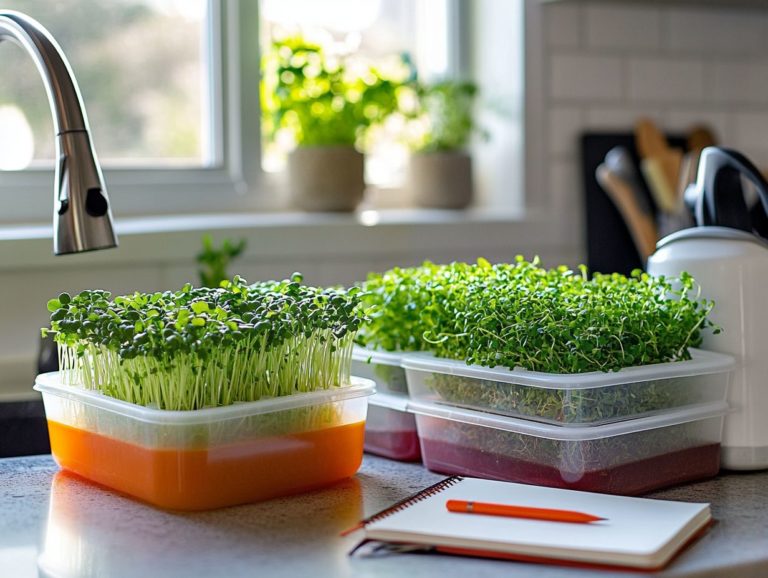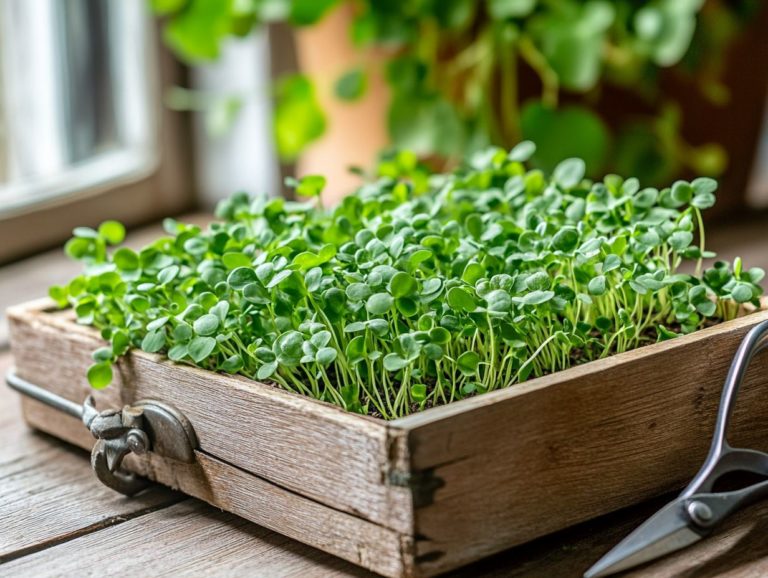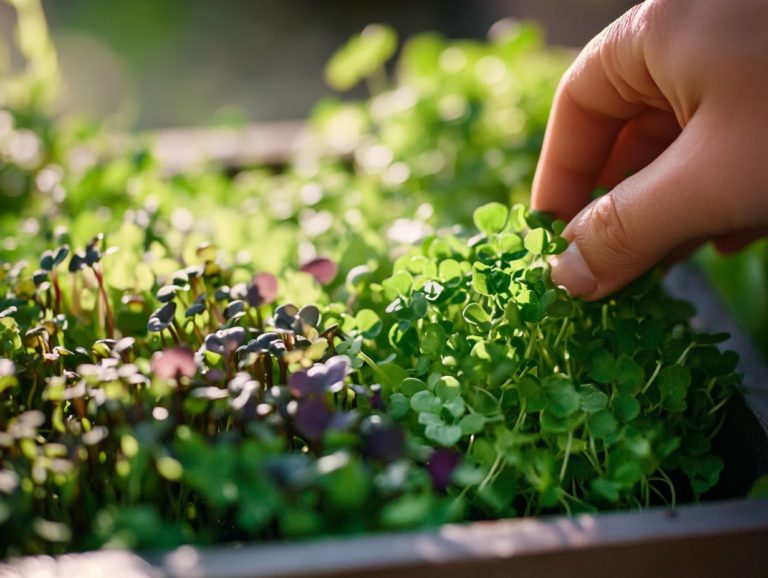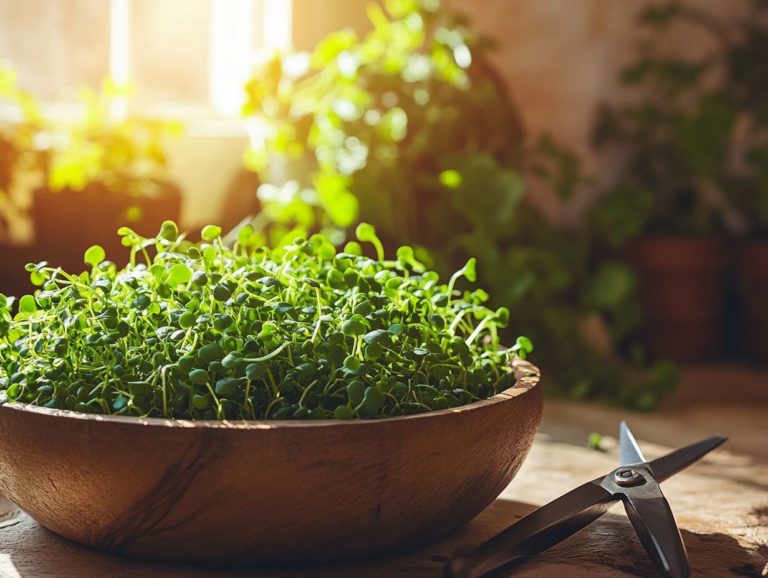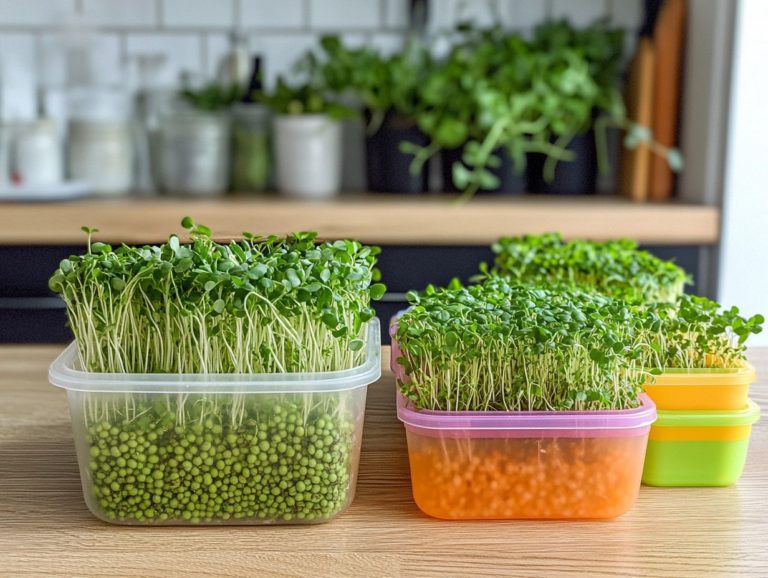Microgreens: Harvesting vs. Cutting
Microgreens are small yet mighty plants that deliver a burst of flavor and nutrition. They make a staple in both gourmet kitchens and health-focused diets. Their vibrant colors and rich microgreen flavors offer a unique twist to salads and dishes alike.
This guide invites you to explore the essential aspects of these vibrant greens. Focus on the harvesting and cutting processes that help you maximize their potential for health benefits and culinary delight. Discover the perfect time to harvest and unlock the full potential of your microgreens!
You ll learn the best techniques for cutting and the pros and cons of each method. You will also discover the culinary and nutritional applications that transform microgreens into an indispensable ingredient. They are vital in microgreen recipes that cater to various dietary needs. Immerse yourself in this knowledge and elevate your culinary creations to new heights!
Contents
- Key Takeaways:
- Harvesting Microgreens
- Cutting Microgreens
- Methods for Cutting
- Benefits of Harvesting vs. Cutting
- Uses for Microgreens
- Frequently Asked Questions
- Curious about what microgreens are? Here s what you need to know.
- What’s the difference between harvesting and cutting microgreens?
- Which method is better for harvesting microgreens?
- Can microgreens be harvested more than once?
- How often should microgreens be harvested or cut?
- What is the best way to store harvested microgreens?
Key Takeaways:
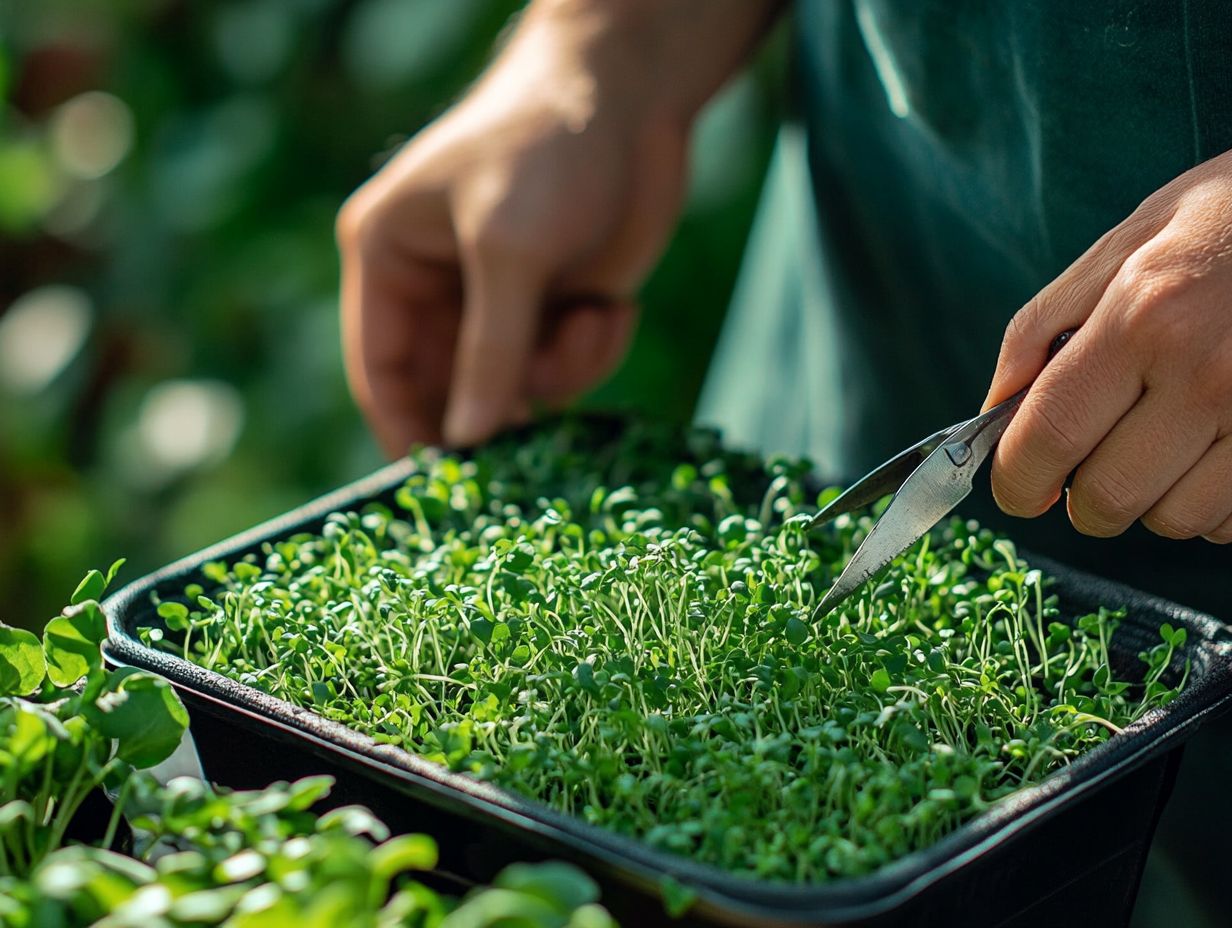
- Harvest microgreens at the right time for maximum flavor and nutrition, ensuring their full nutritional value is captured for your meals.
- Use sharp scissors for harvesting. Leave a small portion of stem for regrowing microgreens, allowing for continual crop sustainability.
- Cutting microgreens can be a convenient and less time-consuming alternative to harvesting but may result in a shorter shelf life.
What are Microgreens?
Microgreens are the young, edible wonders you can harvest just after their first true leaves emerge, typically within 7 to 21 days post-germination. Their rapid growth cycle is an intriguing aspect of plant growth and makes them accessible for home gardeners.
These tiny greens are a powerhouse of flavor, nutrition, and culinary adaptability, earning a special place in the hearts of chefs and health enthusiasts alike. Their potential for diverse cropping and regrowing makes them incredibly appealing whether you re a home gardener or a commercial grower.
Varieties like Peas, Sunflower, and Broccoli are just a few of the popular microgreens known for their impressive concentrations of vitamins and minerals, including Potassium, Zinc, and Magnesium.
Growing microgreens is a straightforward endeavor that can be accomplished in snug spaces, making them perfect for urban gardening or indoor cultivation, especially with the right soil for microgreens. With minimal sunlight and space requirements, these greens thrive in soil or hydroponically, which means growing plants in water instead of soil.
Rich in antioxidants and essential nutrients, microgreens elevate your meals and promote your overall health. They provide a sustainable option for those eager to embrace more plant-based foods in their diets and combat diseases like Diabetes and Heart Disease.
Their rapid growth cycle allows for frequent harvesting, making them an excellent choice for growing food in a way that is good for the environment and supporting food security initiatives.
Harvesting Microgreens
Harvesting microgreens is an essential step in enhancing their nutritional benefits and ensuring peak freshness. Being mindful of when and how to harvest can greatly influence the quality and flavor of your greens.
This process involves mastering a range of harvesting techniques, including clean harvesting. This reduces damage to the plant roots and facilitates effective regrowing of your microgreens, enhancing their longevity.
Timing plays a pivotal role as well; harvesting at just the right moment allows you to capture the full spectrum of nutritional value and the vibrant size that makes these greens so appealing in culinary applications.
When to Harvest
Determining the perfect moment to harvest your microgreens is crucial for capturing their peak flavor and nutritional goodness. This typically occurs between 7 to 21 days after sowing, depending on the specific variety.
When you gaze upon the vibrant greens of basil or cilantro, wait until they develop the second set of leaves. This indicates they ve reached the ideal point for taste and concentrated vitamins.
On the flip side, varieties like Pea Shoots and Sunflower Microgreens can be enjoyed sooner, often just a week after sprouting. Timing is everything; waiting too long can diminish both flavor and nutrient density, impacting their health benefits.
By recognizing these visual cues, you can ensure that your microgreens deliver exceptional taste and nutritional value, fully embracing the energy in seed that these young plants offer.
Proper Techniques for Harvesting
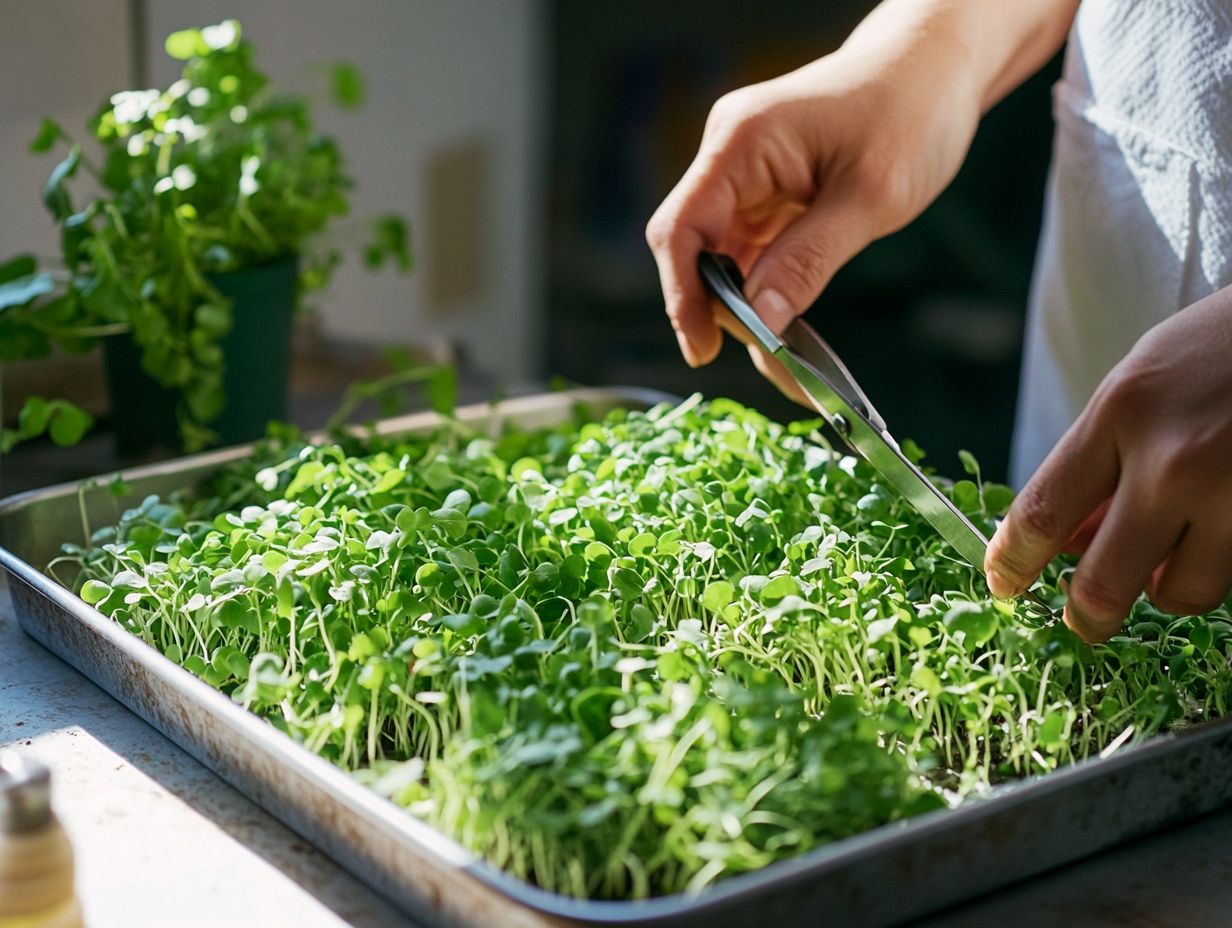
Utilizing the right techniques for harvesting microgreens is essential for preserving their integrity. This ensures you have fresh microgreens that can be enjoyed shortly after cutting.
Use clean harvesting methods by cutting the microgreens just above the soil line. This approach minimizes root disturbance and enhances the chances of regrowth.
Tools like sharp scissors or knives are perfect for the job. Using microgreens trays can streamline your harvesting process while maintaining the quality of your greens and supporting effective storage practices.
Work in a clean environment to avoid contamination, ensuring that your fresh microgreens remain nutritious and flavorful. Harvesting in the morning, when the plants are hydrated and crisp, significantly enhances their flavor and texture.
After cutting, gently shake off any excess soil without damaging the roots and place the greens in a breathable container to prevent wilting. These small yet significant steps will guarantee optimal freshness and elevate the overall quality of your microgreens, making them a delightful addition to any dish.
Cutting Microgreens
Cutting microgreens is an art that demands a keen understanding of timing and technique to unlock their full flavor and freshness. To achieve the best results, harvest them at just the right growth stage, typically just above the soil line.
This method not only preserves their unique flavors but also maximizes their nutritional benefits. Knowing when to make that cut is essential, as it can significantly influence the overall taste experience of the microgreens you enjoy, especially with varieties known for their distinct flavors, such as Mustard and Fenugreek. After harvesting, it’s helpful to know what to do with microgreens to enhance your dishes.
When to Cut
Don t miss the chance to cut your microgreens at the perfect moment for peak flavor! The ideal time typically arrives just after the first true leaves emerge.
However, the timing for this harvest phase can vary significantly across different varieties, such as Radish and Pea Shoots, each boasting unique growth cycles and optimal harvesting heights. Understanding these stages is crucial, as microgreens are brimming with nutrients including vitamins A, C, and K that reach their peak at specific heights.
Timing is particularly critical because harvesting at the right moment elevates their delicate flavors and maximizes the body s ability to absorb those health-boosting compounds. When you harvest at just the right point, you preserve their crisp texture and ensure they deliver the full spectrum of benefits.
Making informed decisions during this process is essential for any enthusiast or professional grower looking to elevate their microgreen game.
Methods for Cutting
Effective methods for cutting microgreens require precision and care to ensure optimal quality and flavor retention. This is especially important when working with delicate plant species.
Using sharp scissors or knives allows for clean cuts just above the stems, minimizing trauma to these delicate plants and supporting their ability to regrow. Employing a technique that involves cutting in a single swift motion can further enhance this process. This reduces any fraying of the plant’s tissues.
Choosing the right tools impacts the immediate quality of your microgreens and influences their longevity post-harvest. This is essential for microgreen storage. To ensure optimal freshness, it’s important to understand the timing of microgreen harvest. Well-cut microgreens tend to retain their freshness and nutritional profile much longer than those that are poorly handled.
Maintaining cleanliness during this process is crucial. It prevents contamination and premature decay, ensuring that your final product remains flavorful and nutritious, showcasing the full-grown plants’ qualities.
Benefits of Harvesting vs. Cutting
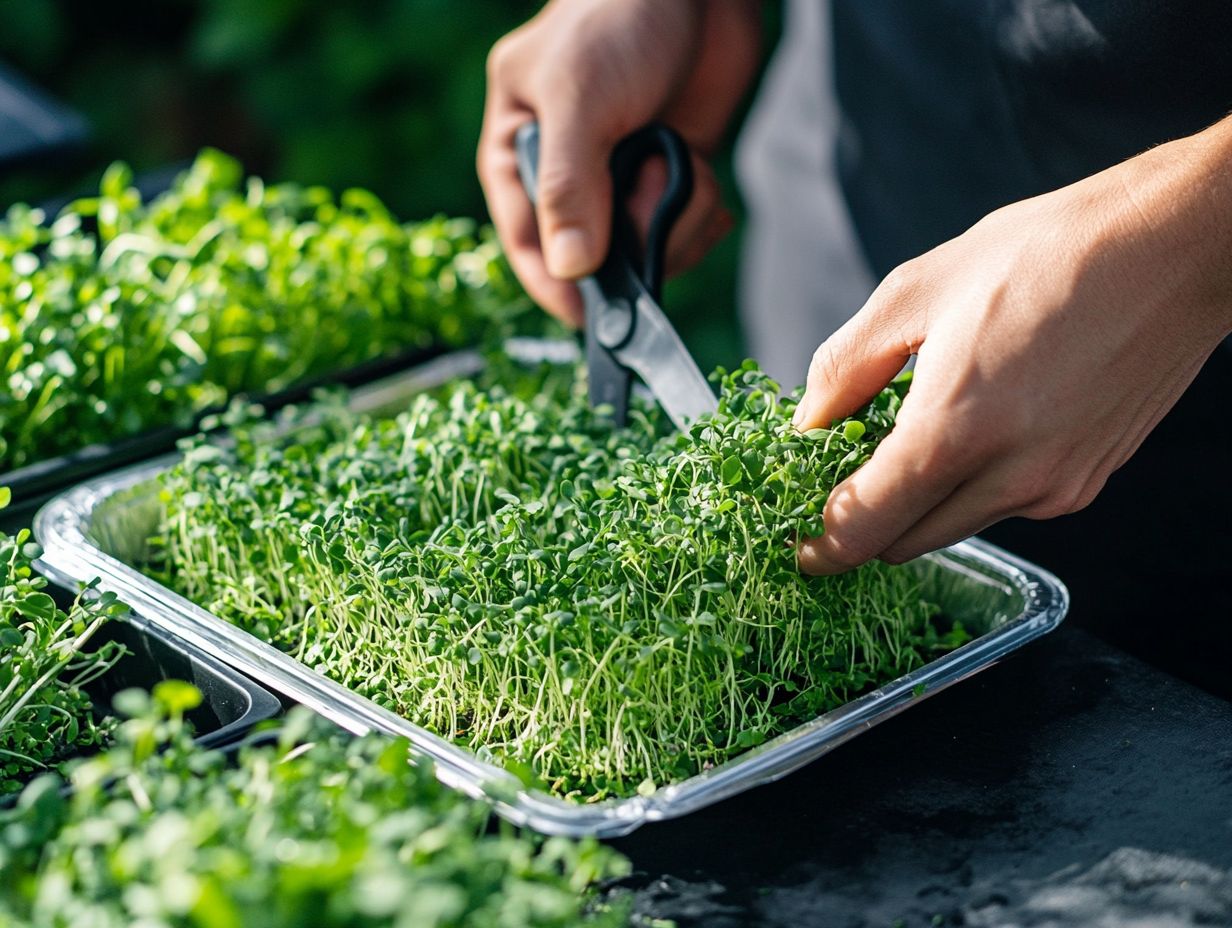
Understanding the benefits of harvesting versus cutting microgreens is crucial for anyone aiming to maximize crop sustainability and health advantages. When you choose to harvest, you collect the entire microgreens, capturing their full nutritional value and exquisite flavors.
Cutting allows for a more continuous yield that fosters ongoing growth. Each method comes with unique advantages and challenges, influencing not only the flavor profile but also the overall health benefits tied to microgreens and their contributions to plant nutrition. To maximize these benefits, understanding microgreen harvest timing is essential.
Pros and Cons of Each Method
Each method of harvesting and cutting microgreens has its own unique advantages and disadvantages. These can greatly influence your choices as a home gardener or commercial grower.
Understanding these differences can impact not only the quality of your harvest but also your overall gardening experience. If you decide to harvest all your microgreens at once, you’ll capture their maximum nutritional profile, transforming them into a powerhouse of vitamins and antioxidants essential for a healthy diet. Additionally, taking care of your microgreens post-harvest is crucial, so be sure to check out understanding microgreen post-harvest care.
If you opt to cut your microgreens, you’ll likely enjoy a longer life cycle for your crops, allowing for multiple harvests from a single planting. However, be mindful; cutting too early may result in diminished flavors and nutrients, which can negatively impact the microgreens’ nutritional benefits. To ensure you’re harvesting at the right time, check out when to harvest.
The sustainability aspect is also worth considering. Responsible harvesting can greatly reduce waste, while cutting requires a delicate balance of nutrients to ensure optimal growth and flavor over time.
Uses for Microgreens
Microgreens are celebrated for their versatility in culinary and nutritional realms. They are essentials in both gourmet kitchens and health-focused diets.
Want to elevate your meals? Imagine enhancing the flavors of your salads and sandwiches with these vibrant little greens! They can also be used as nutritious garnishes that add flair and depth to your dishes.
Beyond their remarkable taste, microgreens can be seamlessly integrated into a variety of recipes, delivering not just delightful flavors but also a wealth of health benefits thanks to their concentrated vitamins and minerals.
Don t wait to enhance your dishes start growing microgreens today!
Culinary and Nutritional Applications
The culinary and nutritional applications of microgreens are truly expansive. They are essential ingredients in gourmet creations and vibrant additions to your everyday meals.
Their unique flavors elevate everything from salads to smoothies. Packed with vitamins A, C, E, and K, they offer significant nutritional benefits to your diet.
When you explore recipes featuring microgreens, you ll find innovative ways to showcase these lively greens and their health-promoting properties. For instance, imagine the peppery kick of radish microgreens enhancing your sandwiches or the fragrant touch of basil microgreens elevating your pasta dishes.
Arugula microgreens can transform the taste of omelets or grain bowls with their slightly spicy flavor. These tiny greens not only enhance your meal s flavor profile but also deliver essential minerals like iron and calcium, making them a savvy choice for anyone looking to boost their health in an exciting way!
Incorporate these greens into your dishes and enjoy the delightful flavors and health benefits they bring!
Frequently Asked Questions

Curious about what microgreens are? Here s what you need to know.
Microgreens are young, edible plants harvested when they are only a few inches tall. They are packed with nutrients like vitamins and minerals and are often used as garnishes or in salads.
What’s the difference between harvesting and cutting microgreens?
Harvesting refers to picking the entire plant, including the roots. Cutting involves snipping off the top portion of the plant above the soil line. Understanding the plant stages can greatly impact your harvesting technique.
Which method is better for harvesting microgreens?
It depends on personal preference and the type of microgreen being grown. Some varieties, such as basil, are better suited for cutting, while others, like radish, are best harvested.
Can microgreens be harvested more than once?
You can harvest microgreens multiple times. Just cut them about an inch above the soil line. The second harvest might not be as flavorful or nutrient-rich as the first. Keep an eye on the size of your microgreens to ensure they regrow well.
How often should microgreens be harvested or cut?
Microgreens are ready to be harvested once they reach your desired size, usually between 1-3 weeks after planting. After that, you can harvest them every 1-2 weeks, depending on how quickly they grow.
Crops grown indoors often need different care than outdoor varieties.
What is the best way to store harvested microgreens?
After you harvest them, store your microgreens in an airtight container in the refrigerator. They can last up to a week, but it’s best to enjoy them right away for the freshest taste! Also, check the nutrients in the soil to keep them healthy.

